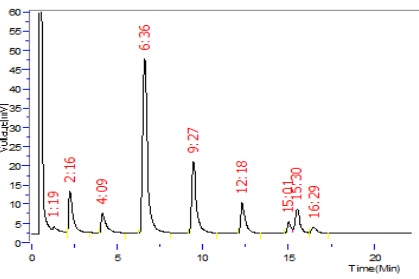Fatty Acid Compositional Analysis of Different Edible Oils and Fats in the kairwara, Alwar (Rajasthan)
Keywords:
Fatty acid, Gas chomatograph, Coconut Fat, Peanut oil, Olive oil, Ricebran oilAbstract
The fatty acid may be either saturated or unsaturated. The main objective of this work was to identify the fatty acid composition of several edible oils and fats. Taking most four different types of edible oils and fats, coconut fat, peanut oil, olive oil, rice bran oil samples were taken, tested with widely accepted and internationally used methodology of Association of ISO 548 Part 3 for used for fatty acids analysis. Fatty acid analysis of the four type of edible oil was carried out using a gas chromatograph equipped with a flame ionization detector, stainless steel packed column. Among the evaluated oils the higher contents of different fatty acids were found in coconut fat (lauric 46.110), peanut oil (oleic 40.750, linoleic 40.477), olive oil (oleic 77.665), rice bran oil (oleic 44.322). The result showed that the coconut oil contained the highest percentage of saturated fatty acids (92.178 %) compared to peanut oil (18.36%), rice bran (19.948%) and olive oil (13.067%) and the olive oil highest percentage of long chain mono and polyunsaturated fatty acids (86.934%) compared to peanut oil (81.641 %), rice bran oil (80.053 %), and coconut oil (7.822 %).
References
D. Islam, “Fatty acid compositional analysis of different edible oils and fats using GC-FID”, IJIR, Vol.2, Issue.10, pp.1017-1038, 2016.
S. Azeez, “Fatty acid profile of coconut oil in relation to nutmaturity and season in selected cultivars/hybrids”, Emeraldinsight, pp.272-279, 2007.
G. Krishna, G. Raj, A. S. Bhatnagar, P. Kumar, P. Chandrashekar, “Coconut oil: chemistry, production and its applications - a review, Indian Coconut Journal, pp.15-27, 2010.
C. Mondragon, M.G., C. D.L. Barca, A.M., D. Prado, A., C. Reyes, L.C., O. Ros, R.M., O. Garcia, J., M. Juarez, L.A., Angulo, “Nutritional composition of new peanut (Arachis hypogaea L.) cultivars”, Grasas Y Aceites, Vol.60, pp.161-167, 2009.
R. Jiang, J. Manson, M. Stampfer, S. Liu, W. Willett, F. Hu, “ Nut and peanut butter consumption and risk of type 2 diabetes in women”, J. Am. Medical Assoc, Vol.20, pp.2554-2560,2002.
N. K. L. Rawashdeh, “Fatty acids pattern of olive oil under organic Farming”, Academia Journal of Agricultural Research, Vol.1, Issue.09, pp.156-160, 2013.
K. J. Reddy, K. Jayathilakan, M.C. Pandey, K. Radhakrishna, “Evalutation of the physic- chemical stability of rice bran oil and its blends for the development of functional meat products”, INTERNATIONAL JOURNAL OF FOOD AND NUTRITIONAL SCIENCES, Vol.2, Issue.2, pp.46-53, 2013.
P. Singh, “Physico-chemical investigations of Mustard seed (Brassica juncea L)”, International Journal of Scientific Research in Multidisciplinary Studies, Vol.4, Issue.6, pp.24-27, 2018.
J. Orsavova, L. Misurcova, J.V. Ambrozova, R. Vicha, J. Mlcek, “ Fatty acids composition of vegetable oils and Its contribution to dietary energy intake and dependence of cardiovascular mortality on dietary intake of fatty acids”, Int. J. Mol. Sci., Vol.16, pp.12871-12890, 2015.

Downloads
Published
How to Cite
Issue
Section
License

This work is licensed under a Creative Commons Attribution 4.0 International License.
Authors contributing to this journal agree to publish their articles under the Creative Commons Attribution 4.0 International License, allowing third parties to share their work (copy, distribute, transmit) and to adapt it, under the condition that the authors are given credit and that in the event of reuse or distribution, the terms of this license are made clear.





